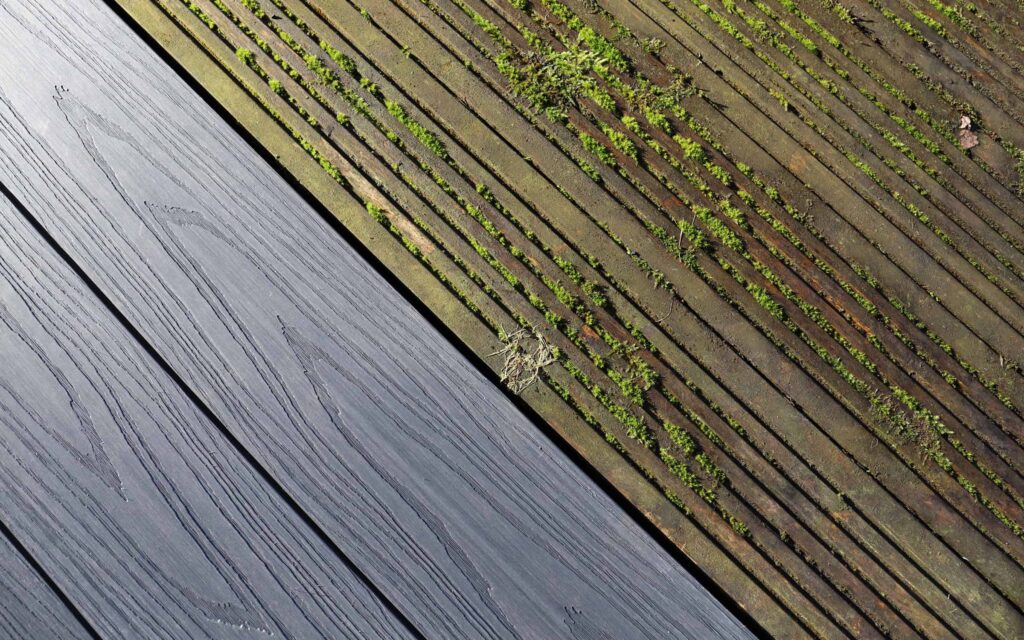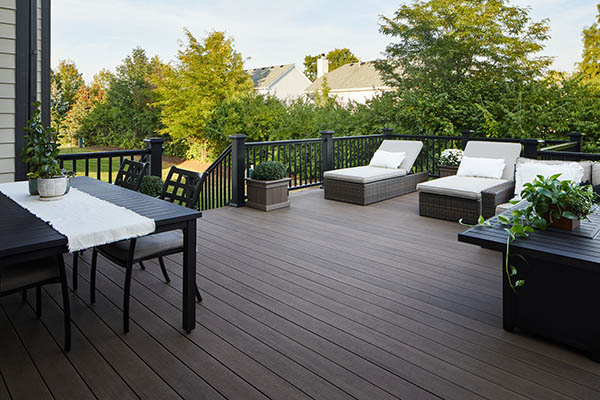
Replacing a deck can significantly enhance outdoor living spaces and boost a property’s value. A well-planned deck replacement not only revitalizes an old structure but also opens the door to modern materials and designs that can cater to various needs and lifestyles. Whether replacing an aging deck or upgrading to suit personal preferences, the process involves several key steps that ensure a successful outcome.
Understanding the scope of a deck replacement project is crucial. Homeowners need to consider aspects like deck removal, material selection, and construction techniques to achieve their desired results. Engaging with professionals can provide expert insight and save time, making the process smoother and more efficient.
Incorporating choices like durable decking materials and appealing accessories can further improve both aesthetics and functionality. By taking the time to plan carefully, one can create a space that is both beautiful and practical for entertaining or relaxing.
Key Takeaways
- Planning is essential for a successful deck replacement.
- Choosing the right materials enhances both durability and style.
- Professional help can streamline the deck replacement process.
Understanding Deck Replacement

Deck replacement becomes necessary when signs of wear and deterioration compromise safety and aesthetics. Recognizing these signs, conducting thorough inspections, and understanding whether to repair or fully replace can guide the decision-making process.
Signs of Deck Wear and Tear
Several indicators suggest a deck may need replacement. Common signs include:
- Visible Damage: Cracks or splintering in the wood can lead to injuries.
- Rot: Prolonged exposure to moisture can cause wood rot, particularly in areas close to the ground or where water pools.
- Mildew Growth: Dark or patchy surfaces may indicate mildew, which can weaken the structure.
Regularly checking for these issues allows for timely intervention, preventing more extensive damage later.
Deck Inspection and Assessment
A comprehensive deck inspection is critical in identifying its condition. Homeowners should focus on:
- Structural Integrity: Look for loose railings, soft spots, or compromised joists. An unstable deck poses serious safety risks.
- Water Damage: Examine areas where water tends to accumulate. Water can accelerate deterioration, leading to rot and mold growth.
- Weathering Effects: Assess the deck surface for signs of fading, warping, or splitting due to weather exposure.
Using tools like moisture meters can help gauge the wood’s health. An in-depth assessment provides valuable insights for informed decisions.
Comparing Repair and Full Replacement
Choosing between repair and full replacement depends on the extent of damage. Consider multifamily decking applications if you’re looking for durable and long-lasting solutions for shared residential spaces. Investing in high-quality decking materials can improve safety, aesthetics, and overall property value. Factors to consider include:
- Extent of Damage: Minor issues like a few loose boards may only require repair, while extensive rot typically necessitates a full replacement.
- Cost: Repairs might seem cost-effective short-term, but recurring issues may accumulate costs over time. Full replacement can save money in the long run.
- Longevity: Consider the remaining lifespan of the current structure. If it is nearing the end, replacement is often the wiser choice.
Understanding these factors will help determine the best approach for maintaining a safe and functional deck.
Planning Your Deck Replacement Project
Planning for a deck replacement involves understanding the scope of work, budgeting effectively, and ensuring all necessary permits are obtained. Each of these elements plays a major role in a successful decking project.
Determining Scope and Material Requirements
Identifying the scope of the deck replacement project is crucial. This includes measuring the existing deck and considering any desired changes, such as size or layout. A thorough assessment helps in selecting appropriate materials.
Material options include:
- Composite decking: Durable and low maintenance, often warrantied for extended periods.
- Pressure-treated wood: A cost-effective choice that requires regular maintenance.
A detailed list of required materials, such as joists, posts, and hardware, will ensure nothing is overlooked during the construction phase.
Budgeting for Deck Replacement Costs
Creating a budget involves estimating costs for materials, labor, and any unforeseen expenses. The average cost of deck replacement varies but typically falls between $15 to $35 per square foot, depending on material choices.
Labor costs typically range from $30 to $70 per hour, depending on local rates and the complexity of the project.
Important budget items include:
- Materials: Type and quality can greatly affect pricing.
- Labor: Skilled contractors may have higher rates.
- Contingency fund: It is wise to allocate 10-15% for unexpected costs.
Careful planning ensures that financial constraints do not compromise quality.
Securing Permits and Preparing for Construction
Before construction begins, it is essential to secure the necessary permits. Most jurisdictions require a permit for deck replacements, especially if changes involve height or size modifications.
Checking local regulations can prevent costly delays. Homeowners should consult with their local building department to determine the specific requirements.
Preparation for construction includes:
- Clearing the area: Remove any furniture or landscaping that may obstruct access.
- Scheduling inspections: Ensure compliance with building codes at various construction stages.
These steps lay the groundwork for a seamless deck replacement process.
Deck Removal Process
Removing an old deck requires a systematic approach to ensure safety and efficiency. Key considerations include dismantling techniques and the proper disposal methods for waste materials.
Dismantling the Old Deck
The dismantling process begins with identifying any loose boards. It’s essential to check for deck screws and galvanized nails securing the deck components. Using a pry bar can effectively lift warped or loose boards without causing damage to adjacent materials.
Next, begin removing the old decking by starting at the edge and working inward. This method prevents the structure from collapsing unexpectedly. If encounters with any stubborn screws occur, a drill with a screw extractor may be necessary. After the decking is removed, disassemble the framework.
Pay attention to the framing components, as they may also have screws or nails. Carefully detach these to avoid injury. Ensure all debris is collected during this phase.
Disposal of Waste Materials
After removal, proper disposal of debris is crucial. It’s advisable to separate materials based on type: wood, metal, and fasteners.
Use a dumpster or designated area in the yard for waste collection. For wood, check local recycling facilities that accept treated lumber. Old deck screws and nails should be disposed of in a metal recycling bin, as they can be harmful if left unsecured.
If possible, consider repurposing components for other projects, such as garden beds or outdoor furniture. Timely disposal minimizes clutter and prepares the site for the new deck installation.
Deck Construction Techniques
Use a dumpster or designated area in the yard for waste collection. Consider renting a dumpster for easier cleanup. For wood, check local recycling facilities that accept treated lumber. Old deck screws and nails should be disposed of in a metal recycling bin, as they can be harmful if left unsecured.
A robust deck requires careful attention to construction techniques to ensure structural integrity and durability. Key processes include building a strong foundation, setting posts and beams, and properly attaching joists and the ledger board.
Building a Strong Foundation
The foundation is crucial for any deck structure. It typically involves concrete footings that extend below the frost line to prevent shifting.
- Footing Size: Generally, footings should be at least 12 inches in diameter for small to medium decks. Larger decks may require wider footings.
- Depth: The depth often ranges from 3 to 4 feet, depending on local frost depths.
Once the footings are set, posts can be anchored securely, ensuring the entire structure remains stable.
Setting Posts and Beams
The next step involves placing the posts and beams that support the deck. Posts, usually made of treated wood, must be accurately measured and installed vertically.
- Post Placement: Each post should be spaced appropriately, typically no more than 8 to 10 feet apart.
- Beams: Beams are then attached to the posts. They should be level and securely fastened to uphold the weight of the deck.
Using metal post anchors can enhance stability, allowing for better weight distribution.
Attaching Joists and Ledger Board
Attaching joists is key for providing support for the decking material itself. Joists run perpendicular to the ledger board, which anchors the deck to the house.
- Joist Spacing: Common spacing for joists is 16 inches on center for residential decks.
- Ledger Board Installation: The ledger board must be securely attached to the home with lag screws, ensuring proper flashing is used to prevent water damage.
Joist hangers provide additional support and stability. The entire joist framework must be checked for levelness before decking installation to maintain structural integrity.
Choosing Decking Materials

Selecting the right decking material is crucial for achieving a durable and aesthetically pleasing deck. The choice often comes down to wood versus composite options, alongside considerations for deck boards and fasteners.
Wood vs. Composite Decking
Wood decking offers natural beauty and a classic look. Common choices include pressure-treated lumber, cedar, and redwood. Each type has unique characteristics:
- Pressure-Treated Lumber: Resists rot and insects but may warp and requires ongoing maintenance.
- Cedar: Naturally resistant to decay, with a rich color that ages gracefully. However, it is generally more expensive.
- Redwood: Offers stunning visuals and durability but can also be costly.
Composite decking, made from a blend of wood fibers and plastic, provides numerous benefits. It is low-maintenance and resistant to fading, splintering, and insects. Capped polymer options enhance durability, providing an additional protective layer.
Selecting Deck Boards and Fasteners
When choosing deck boards, buyers should consider dimensions, colors, and textures. Most common sizes include 5/4 x 6 inches, which ensures a sturdy surface while providing safety and comfort.
Fasteners also play a critical role. Stainless steel screws resist corrosion better than conventional options, particularly in damp environments. Hidden fasteners create a clean surface free of visible screws, enhancing visual appeal.
It is essential to match fasteners to the specific decking material to prevent issues like rot or corrosion. The right combination enhances the deck’s longevity and ensures a stable construction.
Deck Board Installation
Proper deck board installation is crucial for ensuring durability and aesthetic appeal. Understanding the right fastening techniques and spacing will contribute significantly to the success of deck board replacement.
Fastening Techniques and Patterns
Using the correct fastening techniques is essential for secure deck board installation. Deck screws are widely preferred for their strength and resistance to corrosion.
Common fastening patterns include:
- Straight Line: Simple and efficient, used for most applications.
- Staggered: Enhances structural integrity, reducing the risk of warping.
It is important to use the right length of screws, typically 2.5 to 3 inches, to penetrate the joists adequately. Pre-drilling holes can prevent wood splitting, especially in hardwood boards.
Tip: Use color-matched screws to maintain the visual appeal of the deck.
Spacing and Securing Deck Boards
Proper spacing between deck boards helps facilitate drainage and air circulation. A gap of 1/4 inch is standard for most materials.
When securing the boards, experts recommend using spacers or specifying the spacing in advance to ensure uniformity. This helps to achieve a consistent look and reduces the chances of moisture issues.
When cutting boards, a circular saw can be utilized for clean edges. After securing the boards, a final inspection is vital to ensure all fasteners are tight and that spacing remains consistent.
Attention to these details will contribute to a long-lasting deck that withstands the elements.
Deck Features and Accessories
Incorporating specific features and accessories enhances both the functionality and aesthetic appeal of a deck. Key components include railings and stairs, as well as decorative elements that personalize the space.
Installing Railing and Stairs
Deck railings provide safety and style, often complying with local building codes. Popular materials include wood, vinyl, and metal, each available in various styles and colors. For instance, aluminum railings can be sleek and modern, while composite options offer durability and a wide color palette.
Stairs are essential for accessibility and should match the deck’s design. They can feature decorative risers or treads made from wood or composite materials. Brands such as Trex and TimberTech offer installation kits that include matching fascia boards, making the project seamless. It’s important to ensure stairs are built to code for safety.
Adding Finishing Touches and Decor
Finishing touches can bring a deck to life, transforming it into an inviting outdoor space. Accessories such as outdoor furniture, planters, and lighting systems add functionality and character.
Choosing color schemes for cushions and décor can create a cohesive look. Brands like Sunbrella provide weather-resistant fabrics that maintain color vibrancy over time. Moreover, incorporating ambient lighting, like LED strips under railings or string lights overhead, enhances the atmosphere in the evening.
Utilizing these elements not only complements the deck’s design but also improves usability for family gatherings and entertainment.
Finishing and Maintenance
Proper finishing and maintenance ensure the longevity and aesthetic appeal of a newly replaced deck. Attention to staining, sealing, and ongoing care helps prevent issues like mold and deterioration.
Staining and Sealing the Deck
Staining and sealing are crucial steps for protecting wood and composite decking. Stains penetrate the material, enhancing its color while safeguarding against UV rays and moisture.
- Types of Stains:
- Transparent: Maintains natural wood look.
- Semi-Transparent: Adds color while showing grain.
- Solid: Provides a paint-like finish, hiding imperfections.
A high-quality sealer acts as a barrier against water and mold. When applying stain and sealer, ensure the deck is clean and dry. Typically, a new deck should be stained after about 30 days, allowing any new wood to acclimate.
Ongoing Deck Care
Routine maintenance significantly impacts the deck’s durability. Regular cleaning and inspections will prevent buildup of dirt and mold.
- Cleaning: Use a gentle cleanser and a soft brush to prevent damaging the surface.
- Inspect for Damage: Check for loose boards, rusted fasteners, or any signs of wear.
Low-maintenance materials like composite decking might require less frequent care but still benefit from periodic cleaning. Deck owners should reapply stain or seal every 1-3 years, depending on environmental conditions and wear. This proactive approach can save costly repairs down the line.
Professional Deck Replacement Services
Engaging professional assistance for deck replacement offers numerous advantages. The decision to hire an expert can lead to more efficient repairs, better quality materials, and adherence to local building codes.
The Advantages of Hiring a Professional
Choosing to hire a professional for deck replacement provides several key benefits. First, experts bring experience that allows them to identify underlying structural issues, such as warping or splitting, that may not be immediately visible.
They also stay updated on industry standards, ensuring compliance with local regulations. Professionals have access to high-quality materials at competitive prices, which can lead to long-lasting results.
Additionally, hiring a professional can save time. They manage labor costs effectively, avoiding potential delays associated with DIY approaches. Ultimately, a skilled contractor can help achieve a safe and visually appealing deck that enhances property value.
Selecting a Deck Replacement Contractor
Selecting the right contractor for deck replacement requires careful consideration. Start by researching local companies with positive reviews and verified credentials. It’s essential to check for licenses and insurance to protect against liabilities.
Ask for references to assess previous work quality. Many reputable contractors offer free estimates, allowing homeowners to compare labor costs and materials used.
It’s also beneficial to discuss timelines and methods during the initial consultation. Clear communication regarding expectations will help ensure that the project progresses smoothly and meets the homeowner’s needs. Prioritize contractors who provide a detailed contract outlining all aspects of the work.
- 3shares
- Facebook0
- Pinterest0
- Twitter3
- Reddit0


